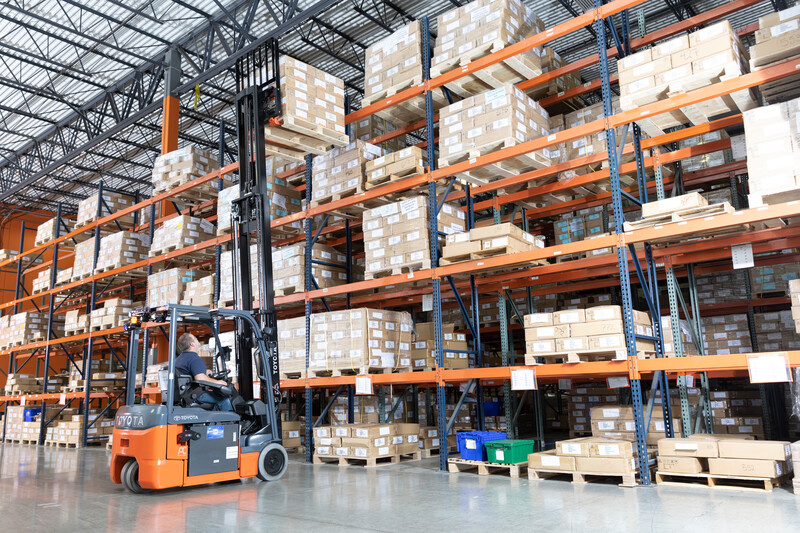In the world of warehousing, efficiency is king. Every square foot of space needs to be optimized to ensure smooth operations, quick access to products, and minimal downtime. The layout of your warehouse racking system plays a critical role in achieving this efficiency. In this blog, we’ll explore key strategies for designing warehouse racking layouts that maximize space, enhance productivity, and support your business’s operational goals.
Understanding Your Space and Inventory
Before diving into the design process, it’s essential to have a clear understanding of your warehouse space and the inventory you store. This includes:
– Warehouse Dimensions: Measure your space accurately, noting the height, width, and length of the area where racking will be installed. Consider any obstructions like columns, doors, or ventilation systems that could affect racking placement.
– Inventory Type: Consider the size, weight, and handling requirements of your inventory. Are you storing large pallets, small items, or a combination? The type of goods will dictate the type of racking system that best suits your needs.
– Throughput Requirements: Determine how quickly items need to be moved in and out of your warehouse. High-turnover products may require easy access, while slower-moving items can be stored in less accessible areas.
Selecting the Right Racking System
Choosing the appropriate racking system is the next step in designing an efficient layout. The type of racking you select should align with your inventory type and handling needs. Common racking systems include:
– Selective Racking: Ideal for warehouses that need direct access to each pallet. It’s versatile and easy to reconfigure, but it doesn’t maximize storage density.
– Drive-In/Drive-Through Racking: Best for high-density storage of similar products. It allows forklifts to enter the racking structure, making it perfect for last-in, first-out (LIFO) operations.
– Push-Back Racking: Provides high-density storage while maintaining selectivity. Pallets are stored on a slight incline, allowing them to “push back” when a new pallet is loaded.
– Pallet Flow Racking: Uses gravity to move pallets from the loading end to the picking end. This system is excellent for first-in, first-out (FIFO) inventory management.
– Cantilever Racking: Ideal for storing long or bulky items like lumber, pipes, or furniture. It offers easy access and can be adjusted to different load sizes.
Optimizing Aisle Widths and Layouts
The layout of your aisles is a critical factor in warehouse efficiency. The goal is to strike a balance between maximizing storage space and ensuring that material handling equipment can operate smoothly.
– Standard Aisles: Typically range from 10 to 12 feet wide. These are common in warehouses using standard forklifts. While they offer flexibility, they do consume more space.
– Narrow Aisles: Usually 8 to 10 feet wide. Narrow aisles require specialized forklifts but allow for more racking units to be installed, increasing storage capacity.
– Very Narrow Aisles (VNA): Measure 6 feet or less. VNAs maximize storage density but require highly specialized equipment. This layout is ideal for high-volume warehouses with limited space.
– Cross Aisles: Consider incorporating cross aisles to improve the flow of traffic and reduce travel time within the warehouse. These can be especially beneficial in larger facilities.
Implementing Zoning for Efficiency
Zoning is the practice of organizing your warehouse into different areas based on product characteristics or workflow. Effective zoning can reduce travel time and improve picking accuracy.
– High-Frequency Zones: Place fast-moving items in easily accessible areas near shipping and receiving docks. This reduces travel time and speeds up order fulfillment.
– Bulk Storage Zones: Designate areas for storing large quantities of similar items. These zones are typically located in less accessible areas since they don’t require frequent picking.
– Specialty Zones: Create zones for items that require special handling, such as hazardous materials, temperature-sensitive goods, or high-value products. This ensures that these items are stored and accessed safely and efficiently.
Leveraging Technology for Layout Optimization
Technology can play a significant role in optimizing warehouse racking layouts. Consider the following tools:
– Warehouse Management Systems (WMS): A WMS can help you track inventory, manage space, and optimize picking routes. Some systems even offer simulation tools to test different layouts before implementation.
– Automated Storage and Retrieval Systems (AS/RS): AS/RS can significantly increase storage density and picking speed by automating the movement of goods within the warehouse.
– Mobile Racking Systems: These systems allow racking units to move along tracks, reducing the need for fixed aisles and maximizing space utilization.
Planning for Flexibility and Growth
While it’s important to design a layout that meets your current needs, it’s equally crucial to plan for the future. As your business grows, your warehousing needs may change. Designing a flexible racking layout can save you time and money in the long run.
– Modular Racking Systems: Choose racking systems that can be easily reconfigured or expanded as your inventory and operational needs evolve.
– Scalability: Ensure your layout can accommodate additional racking units or equipment if needed. Leave space for potential expansion in high-demand zones.
Designing an efficient warehouse racking layout requires careful planning and consideration of your space, inventory, and operational goals. By selecting the right racking system, optimizing aisle widths, implementing effective zoning, and leveraging technology, you can create a layout that maximizes space, enhances productivity, and supports the growth of your business.
Remember, the ultimate goal is to create a warehouse environment where everything is in its place, easily accessible, and efficiently managed. With the right layout, your warehouse can become a well-oiled machine, driving your business forward.
